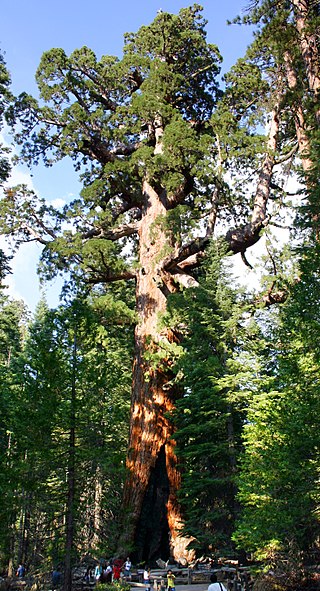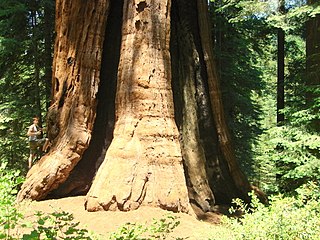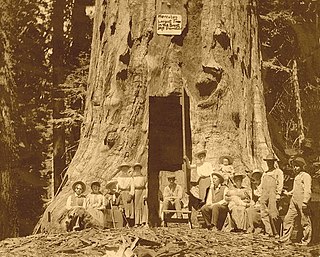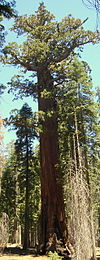
Sequoiadendron giganteum, also known as the giant sequoia, giant redwood or Sierra redwood is a coniferous tree, classified in the family Cupressaceae in the subfamily Sequoioideae. Giant sequoia specimens are the most massive trees on Earth. They occur naturally only in groves on the western slopes of the Sierra Nevada mountain range of California.

The General Grant tree is the largest giant sequoia in the General Grant Grove section of Kings Canyon National Park in California and the second largest giant sequoia tree in the world. Once thought to be well over 2,000 years old, recent estimates suggest the General Grant tree is closer to 1,650 years old. The tree also features the third largest footprint of any living giant sequoia, measuring 107.6 ft (32.8 m) in circumference at ground level.

The Giant Forest, famed for its giant sequoia trees, is within the United States' Sequoia National Park. This montane forest, situated at over 6,000 ft (1,800 m) above mean sea level in the western Sierra Nevada of California, covers an area of 1,880 acres (7.6 km2). The Giant Forest is the most accessible of all giant sequoia groves, as it has over 40 mi (64 km) of hiking trails.

Mountain Home Grove is a grove of giant sequoia trees located in the southern part of the Sierra Nevada Mountains of California, and includes some of the largest trees in the world.

Lost Monarch is a coast redwood tree in Northern California that is 26 feet (7.9 m) in diameter at breast height, and 320 feet (98 m) in height. It is the world's fifth largest coast redwood in terms of wood volume.

The Boole Tree is a giant sequoia in the Giant Sequoia National Monument, Fresno County, California. The Boole Tree is the eighth tallest sequoia in the world and is the largest in terms of base circumference at 113 feet. It is estimated to be more than 2,000 years old. The tree's stature is accentuated by its isolation above the Kings River where it towers over the rest of the forest.

The Stagg Tree, officially the Amos Alonzo Stagg Tree and formerly known as the Day Tree, is a giant sequoia in Alder Creek Grove in California's Sierra Nevada mountains. It is the fifth largest tree in the world and the tallest giant sequoia south of Lincoln in Sequoia National Park. Stagg features the second largest footprint of any living giant sequoia, measuring 109 ft (33 m) in circumference at ground level, and second only to Boole. The tree is believed to be over 3,000 years old, making it one of the oldest living giant sequoias.

The Genesis Tree is a giant sequoia that is the seventh largest tree in the world. It is located within the Mountain Home Grove, a giant sequoia grove located in Mountain Home Demonstration State Forest in the Sierra Nevada of eastern California. The Genesis Tree was heavily damaged by the Castle Fire in 2020.

Franklin is a giant sequoia in Giant Forest, a sequoia grove where the largest tree in the world lives - the General Sherman. The Franklin tree is the eighth largest giant sequoia in the world. It was named by Wendell Flint after Benjamin Franklin. Nearby trees include the Washington Tree which was once the second largest tree in the world, but since it lost half its trunk in 2005 many sequoias are now larger.

The Grizzly Giant is a giant sequoia in Yosemite National Park's Mariposa Grove. It has been measured many times; in 1990 Wendell Flint calculated its volume at 34,005 cubic feet (962.9 m3), making it the 26th-largest living giant sequoia.

The Robert E. Lee tree is the second largest giant sequoia in the Grant Grove section of Kings Canyon National Park, and the eleventh largest giant sequoia in the world. Richard Field, a Confederate lieutenant, named this tree in honor of Robert E. Lee around 1875. In 2020, Sequoia and Kings Canyon National Parks removed references to the name in Park materials, in an effort to promote inclusiveness following the George Floyd protests; however, the name cannot be changed without the approval of Congress or the National Park Service.

The Adam Tree is a giant sequoia located in Mountain Home Grove, a sequoia grove in Giant Sequoia National Monument in the Sierra Nevada of California. It is the 21st largest giant sequoia in the world, and could be considered the 20th largest depending on how badly Ishi Giant atrophied during the Rough Fire in 2015.

The Hart Tree is a Giant sequoia tree within the Redwood Mountain Grove, in the Sierra Nevada and Fresno County, California. The Redwood Mountain Grove is protected within Kings Canyon National Park and the Giant Sequoia National Monument. It is the 25th largest giant sequoia in the world, and could be considered the 24th largest depending on how badly Ishi Giant atrophied during the Rough Fire in 2015.

The General Noble Tree was a monumental giant sequoia situated in the Converse Basin Grove, within the boundaries of the Giant Sequoia National Monument, in Fresno County, California. It was believed to be the biggest tree in the world before its felling in 1892 for an exhibit at the World's Columbian Exposition in Chicago. It was the largest tree ever felled.

The Methuselah Tree is a giant sequoia located in Mountain Home State Forest, a sequoia grove located in Sequoia National Forest in the Sierra Nevada in eastern California. It is the 28th largest giant sequoia in the world, and could be considered the 27th largest depending on how badly Ishi Giant atrophied during the Rough Fire in 2015.

The Hercules Tree in the Mountain Home Grove of California is a living giant sequoia tree that has a room carved into the center of it. It is also known as the "Room Tree".
The Summit Road Tree is a giant sequoia located in the Mountain Home Grove, one of several sequoia groves found in the southern Sierra Nevada of California. It is the 16th largest giant sequoia in the world, and could be considered the 15th largest depending on how badly Ishi Giant atrophied during the Rough Fire in 2015.
The Euclid Tree is a giant sequoia located in the Mountain Home Grove, one of several sequoia groves found in the southern Sierra Nevada of California. It is the 17th largest giant sequoia in the world, and could be considered the 16th largest depending on how badly Ishi Giant atrophied during the Rough Fire in 2015.

Chief Sequoyah is a giant sequoia located within the Giant Forest of Sequoia National Park in California. It is the 9th largest tree in Giant Forest grove, the 27th largest giant sequoia in the world, and could be considered the 26th largest depending on how badly Ishi Giant atrophied during the Rough Fire in 2015.



















